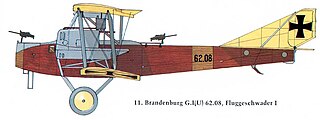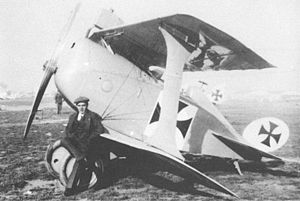
The Sopwith Triplane is a British single seat fighter aircraft designed and manufactured by the Sopwith Aviation Company during the First World War. It has the distinction of being the first military triplane to see operational service.

A triplane is a fixed-wing aircraft equipped with three vertically stacked wing planes. Tailplanes and canard foreplanes are not normally included in this count, although they occasionally are.

The Albatros D.III was a biplane fighter aircraft used by the Imperial German Army Air Service during World War I. A modified licensed version was built by Oeffag for the Austro-Hungarian Air Service (Luftfahrtruppen). The D.III was flown by many top German aces, including Wilhelm Frankl, Erich Löwenhardt, Manfred von Richthofen, Karl Emil Schäfer, Ernst Udet, and Kurt Wolff, and Austro-Hungarians like Godwin von Brumowski. It was the preeminent fighter during the period of German aerial dominance known as "Bloody April" 1917.

The Albatros D.II was a German fighter aircraft used during World War I. After a successful combat career in the early Jagdstaffeln, it was gradually superseded by the Albatros D.III.

The Austro-Hungarian Aviation Troops or Imperial and Royal Aviation Troops were the air force of the Austro-Hungarian Empire until the empire's demise in 1918; it saw combat on both the Eastern Front and Italian Front during World War I.

The Aviatik (Berg) D.I, was a single-engine, single-seater biplane fighter that was developed and manufactured by the Austro-Hungarian branch of German aircraft company Aviatik. It was also known as Berg D.I or the Berg Fighter, because it was designed by Dipl. Ing. Julius von Berg, and to distinguish it from the D.I fighter built by the parent Aviatik firm in Germany.

The Hansa-Brandenburg CC was a single-seat German fighter flying boat of World War I. It was used by both the Kaiserliche Marine and the Austro-Hungarian Navy.

The Hansa-Brandenburg D.I, also known as the KD was a German fighter aircraft of World War I. Despite poor handling characteristics it was put into service by Austria-Hungary, where some aircraft served until the end of the war.

The Hansa-Brandenburg G.I was a bomber aircraft used to equip the Austro-Hungarian aviation corps in World War I. It was a mostly conventional large, three-bay biplane with staggered wings of slightly unequal span. The pilot and bombardier sat in a large open cockpit at the nose of the aircraft, with a second open cockpit for a gunner in a dorsal position behind the wings. An unusual feature was the placement of the twin tractor engines. While the normal practice of the day was to mount these to the wings, either directly or on struts, the G.I had the engines mounted to the sides of the fuselage on lattices of steel struts. This arrangement added considerable weight to the aircraft and transmitted a lot of vibration to the airframe.

The Blackburn Triplane was a single-engine pusher single-seater, designed specifically to attack Zeppelins. It flew in 1917, but was not successful.

The Aviatik C.I, the prototypes of which were known as Aviatik 30.14, Aviatik 30.15 and Aviatik 30.16, was an Austro-Hungarian 2-seat reconnaissance aircraft produced from 1917.(Note: the is not part of the designation, but used to disambiguate from the German-built Aviatik aircraft with the same designation.)
The Armstrong Whitworth F.K.5 and F.K.6 were experimental triplanes built as escort fighters by Armstrong Whitworth during the First World War. They carried two gunners in nacelles mounted on the centre wing. One example of each type was built, with no further development or production following.
The Boulton & Paul P.12 Bodmin was an experimental British twin-engined biplane bomber with its engines mounted in a fuselage engine room and with tandem pairs of tractor and pusher airscrews mounted between the wings. The two Bodmins built flew in 1924, proving the concept but the layout was not developed to production.
In aviation, a multiplane is a fixed-wing aircraft-configuration featuring multiple wing planes. The wing planes may be stacked one above another, or one behind another, or both in combination. Types having a small number of planes have specific names and are not usually described as multiplanes:

The Kondor D 7 was a prototype German single seat biplane fighter built over the winter of 1917-18. It was not a success and its development was soon abandoned.

The LFG Roland D.IX was a World War I German single seat fighter aircraft, a biplane powered by one of a new generation of powerful rotary engines. Three slightly different prototypes were built but there was no series production.

The Lloyd 40.08 Luftkreuzer was a three engine triplane bomber type built during World War I. The design was proven to be ineffective and development did not proceed past the prototype stage.

The Wight Quadruplane, also referred to as the Wight Type 4, was a British single seat quadruplane fighter aircraft built by J Samuel White & Company Limited during World War I. Testing revealed design deficiencies and after the only example was involved in a crash, further work on the aircraft was abandoned.
The Aviatik 30.24 was a prototype Austro-Hungarian triplane fighter built by Aviatik in World War I.
The Hansa-Brandenburg C.II, company designation K,, was a two-seat reconnaissance aircraft built in Germany by Hansa-Brandenburg in World War I, powered by Mercedes D.III or Hiero 6 water-cooled in-line piston engines.


















